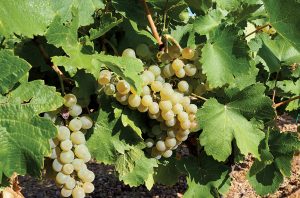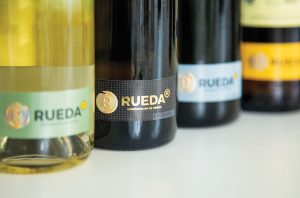What makes a wine region worth knowing? The presence of high-quality wines is, obviously, a sine qua non, along with consistency. But perhaps most important of all, in a competitive wine world where more regions than ever are attaining those two benchmarks, is a third, more elusive character, shared by all the best wine regions: a strong, distinctive personality.
Does Rueda meet this trio of exacting criteria? The tasting Decanter hosted in the process of putting this article together featured several dozen examples of Rueda wines. The line-up was dominated by the region’s signature dry white wines, but within that category there was a very broad range of price points and winemaking approaches to explore. By the end of the tasting, our notebooks were filled with descriptions of consistently good quality wines, which, while different in their own way, all shared certain characteristics that firmly identified them as Rueda. These were wines that could not come from anywhere else and should have a place in any drinking repertoire.
The Rueda character: The rule of three
One might ask then, what gives Rueda wines their unique, strong personality. Multiple factors come into play, shaping the identity of one of Spain’s most progressive wine regions.
Broadly speaking, it’s possible to identify three main areas that make Rueda stand out from the crowd: grape variety, climate, and geology. Before delving into the second two factors, let’s look at the single characteristic for which the region is best known: nobody makes dry white wine like Rueda does with its signature variety, Verdejo.

Having been grown in the region for more than 10 centuries, Verdejo is firmly embedded in Rueda’s terroir. And, as seen in the tasting notes below, it’s a variety capable of great stylistic range. Verdejo’s essential character is its aromatic exuberance, its natural mouth-filling fruitiness, its flowing, mouthwatering acidity and – the key, perhaps, to its compelling drinkability – a distinctive, satisfyingly bitter streak, notably on the finish. A classic Rueda Verdejo might have flavours of lime and orange citrus bursting on the tongue, along with succulent tropical and Mediterranean orchard fruit, and notes that are highly evocative of the Rueda region itself: mountain herbs and fennel, a touch of wild flower. That satisfying bitterness may take the form of citrus pith or zest, nuts (almonds) or macerated herbs. Put together, it’s an electric combination impossible to find elsewhere.
Indeed, Verdejo does seem uniquely suited to the local conditions up on the high plains of Castilla y León to the north of Madrid. Altitude – the vineyards are planted between 700 and 921 metres above sea level – plays an important role in shaping the climate, which features long cold winters, and hot dry summers. Crucially, while the summer days are hot and sunny, the nights are decidedly cool, and the enormous difference between day and night-time temperatures allows for the development of grapes that retain their characteristic, pronounced freshness and drive, while developing aromatic complexity.
No less important for the Verdejo character are the soils. Rueda sits in the central part of the depression formed by the River Duero, with broad alluvial terraces running down to the banks of the Duero itself and its tributaries, the Trabancos, Zapardiel, and Adaja. In general the brown soils are rich in calcium and magnesium, with limestone outcrops and sandy-loamy and loamy textures, while many of the best vineyards are grown on gravelly plots.

The many faces of Rueda
The Rueda vineyards are not just ideal for Verdejo. Other white varieties that thrive in the region include Sauvignon Blanc, which arrived in the 1970s and produces lively, aromatic wines both in single varietal bottlings and as a complementary blending partner with Verdejo; Viura, best known for its role as the leading white varietal in Rioja; and Palomino Fino, of sherry fame. Both Viognier and Chardonnay have also been permitted in the region since 2019. And while not the region’s main focus, reds (and rosés) have always been a feature of Rueda, too, with a small but intriguing portion of the Rueda vineyard today devoted to red varieties such as Tempranillo, Cabernet Sauvignon, Merlot, Syrah, and Garnacha.
As the tasting showed, however, dry white wines are the key force in shaping Rueda’s modern reputation, and they are increasingly diverse. Some of that range can be attributed to the winemaking approaches applied by individual winemakers (see box for the most significant stylistic variations). But the Rueda DO has also been busy enshrining variety in the way that the region’s wines are sold, having introduced new categories that reflect differences in terroir, vine age, and method.
Browsing the Rueda selection, one can find three main categories of dry white wine. The biggest is the region-wide Rueda category, which must contain at least 50% of Verdejo or Sauvignon Blanc: it’s here one finds the classic, fresh, youthful, vividly fruity dry white wines that are synonymous with Rueda and have made it the most popular white wine-producing region in Spain.
Sitting just above in the quality pyramid is Vino de Pueblo, which comprises wines that can indicate the village or town where the grapes are grown on the label, provided the percentage of fruit hailing from the mentioned place is more than 85%.

Finally, Gran Vino de Rueda (GVR), which represents some of Rueda’s finest white cuvées, reflects one of the region’s greatest resources: its stock of old and very old (some date back to before the spread of phylloxera) vines. To earn the right to the GVR label, the wine must be produced from vines that are more than 30 years old, with controlled yields of less than 6,500 kg/ha.
These exciting terroir wines are joined by a range of traditional fortified wines – Rueda Dorado and Rueda Pálido – that, while small in number these days, can, at their best provide some thrilling wine-drinking experiences. A small, sometimes charming selection of sparkling Rueda Espumoso wines add further interest to the mix that makes this dynamic wine region well worth exploring.
Rueda’s many white winemaking styles
The Decanter tasting of a wide range of Rueda wines featured a variety of winemaking approaches, leading to a broad palette of styles and textures.
Classic modern Rueda: Cold fermentation in stainless steel, which gives the Verdejo (and Sauvignon Blanc) fruit the chance to shine in all its exuberant aromatic glory.
Sobre lías: A number of Rueda’s finest dry whites are made with extended lees contact (‘sobre lías’) and bâtonage, bringing more weight and savoury complexity of flavour.
Oak-fermented and aged: In a manner not dissimilar to the Sauvignon Blanc and Sauvignon-Sémillon blends of Bordeaux, Rueda Verdejo and Sauvignon Blanc can respond well to fermentation and ageing in barrel, with the best examples providing gastronomic richness and long-ageing potential.
Tinajas: The currently fashionable revival of clay-pot winemaking in tinajas or amphorae shows great promise in Rueda, bringing harmoniously textured wines in which Verdejo’s wild herbal side comes to the fore.
Flor ageing: ‘Biological ageing’ of wines under a layer of flor yeast is a skill Rueda winemakers have learned after years of making fortified wines (Rueda Pálido and Dorado), a tradition that goes back to the times of Catholic Monarchs’ rule. It’s exciting to see winemakers bringing the same technique to unfortified dry white wines, bringing a subtle yeasty-nutty dimension.
 Bodegas Naia, Náiades 2019
Bodegas Naia, Náiades 2019
93
Burgundian nose of smoky oak and toasted almonds. Racy, tangy and savoury palate with good energy flow and a spicy lining. Will age well, but excellent gastronomic fare now, with that classic Verdejo bitter-tang on the long finish. Alc 13.5%
 Bodegas Pita, Pita Finca La Cantera 2019
Bodegas Pita, Pita Finca La Cantera 2019
93
There’s a nice savoury intrigue to this elegant wine – very serious stuff here. Multilayered with subtly smoky oak, cream, peach and a streak of lime. Herbal earthiness running underneath. Lovely depth and pillowy texture. Long, pithy finish. Alc 13%
 Rodríguez y Sanzo, Rodríguez & Sanzo Bajo Velo 2021
Rodríguez y Sanzo, Rodríguez & Sanzo Bajo Velo 2021
93
Intriguing nose – very savoury and dry with just a touch of honey, hay and chamomile. Nice presence and flow and a good long, juicy subtly bitter-infused finish. A nice example of what flor ageing can bring to a dry white wine. Complex and moreish. Alc 13%
 Finca Montepedroso, Finca Montepedroso Verdejo 2021
Finca Montepedroso, Finca Montepedroso Verdejo 2021
92
Lovely pure and vibrant and clear expression of Verdejo, with fennel and a real squirt of thirst-quenching mouthwatering blood orange. Very satisfying and succulent. Alc 12.5%
 Herrero Bodega, Robert Vedel Cepas Viejas 2020
Herrero Bodega, Robert Vedel Cepas Viejas 2020
92
Filigreed nose of clementine, green apple, and a touch of linden and elderflower. Very pretty and fragrant but with nice intensity and focus too. A hint of almond and nice rounded feel in the mouth. Good flow and a touch of wet-stone mineral freshness. Alc 13%
 Marqués de Riscal, Finca Montico 2021
Marqués de Riscal, Finca Montico 2021
92
Clean and crisp – immaculate expression of Verdejo varietal character, with cleansing orange and ripe apple, peach and pear. Gentlky textured but with great acid drive. Nice juicy finish. Organic certified. Alc 13%
 Bodegas Vidal Soblechero, Amarre Lías 2016
Bodegas Vidal Soblechero, Amarre Lías 2016
92
Rich nose of butterscotch and lemon on toast. Good energy on the palate, with fleshy fruit. A leesy touch of sourdough, and lots of macerated herbal tones amassing on the finish. Vibrant, showing the ageing potential of Verdejo even if it might have been slightly more intersting when younger. Alc 13%
 Bodega Matarromera, Emina Verdejo Fermentado Barrica 2018
Bodega Matarromera, Emina Verdejo Fermentado Barrica 2018
91
Generous, fleshy fruit: ripe quince, pear, red apples, plus a touch of melon and pineapple. A bit hollow on the mid palate but with an interesting zesty lift to the finish. Refreshing spicy lining of white pepper and fennel. Alc 13.5%
 Bodega La Granadilla, Dominio de la Granadilla Verdejo Fermentado en Barrica 2021
Bodega La Granadilla, Dominio de la Granadilla Verdejo Fermentado en Barrica 2021
91
Although at the forefront, the oak doesn’t obscure the intensity of preserved lemon, yellow apple and melon. Subtle toasty grip on the mid palate and delicious saline finish. An ideal food companion. Alc 13.5%
 Bodegas Viore, Viore Sobre Lías 2021
Bodegas Viore, Viore Sobre Lías 2021
91
Nice depth of orange, pear and juicy white peach. Layers of fresh fruit flavour with salty and leesy nuances (toast and almonds), depth and texture. Good salty length. Alc 13%
 Bodegas González Byass, Beronia Verdejo 2022
Bodegas González Byass, Beronia Verdejo 2022
90
Floral nose dominated by sweet camomile and linden. The palate has succulent
white peach, melon, gooseberry, cream and fennel, with a refreshing touch of sweet pink grapefruit. Very lifted and lipsmacking. Alc 13%
 Bodega Gótica, Trascampanas Verdejo 2022
Bodega Gótica, Trascampanas Verdejo 2022
90
Interesting fruit quality – ripe and candied lime and grapefruit, wrapping the yellow apple and pear. Nice juicy feel, and a burst of fresh tangy acidity and macerated herb on the finish. Pleasant textural grip. Alc 13%
 Bodegas LAN, LAN Verdejo 2022
Bodegas LAN, LAN Verdejo 2022
90
Restrained and savoury with a leesy character bringing nuance to the nose and palate. Nice tingling fresh lemon and lime zest – fluent and racy finish with a pithy rather than herbal bitter finish. Angular, mineral quality to the zesty fruit. Alc 13.5%
 Vinos Sanz, Finca la Colina Verdejo Cien x Cien 2021
Vinos Sanz, Finca la Colina Verdejo Cien x Cien 2021
90
Very pure white fruit – white peach, crunchy pear, melon in gentle, soft style – supported by macerated herb and lime skin zip coming through on the finish. Long, pleasantly bitter-herbal finish. Alc 13.5%
 Bodega Copaboca, Juan Galindo Verdejo 2021
Bodega Copaboca, Juan Galindo Verdejo 2021
90
Lovely, elegant nose with gentle floral nuances over fleshy citrus and orchard fruit. Intense but refined with lots of juicy lime, lemon and pithy bitterness. Racy and elegant with linear structure and good finish. Alc 13.5%
 Bodegas Moha, Sapientia Verdejo Organic Wine 2021
Bodegas Moha, Sapientia Verdejo Organic Wine 2021
90
Intriguing pineapple meets lime and honey aromas. Good persistence of lemon zest, yellow apple and crunchy pear on the palate with a subtly spicy character, sweet creaminess and pithy finish. Organic certified. Organic Alc 12.5%
 Marqués de Cáceres, Marqués de Cáceres Verdejo 2022
Marqués de Cáceres, Marqués de Cáceres Verdejo 2022
90
Clean and lively ripe fruit salad nose. Good presence and fleshy fruit on the palate, but nice and fluent too. Gentle touch of hay, chamomile amd elderflower. Very accessible, with a subtle, but very satisfying bitter finish. Alc 14%
Gran Vino de Rueda
 Blanco Nieva, Pie Franco Gran Vino de Rueda 2020
Blanco Nieva, Pie Franco Gran Vino de Rueda 2020
94
Superb, Burgundian nose. Rich citrus underscored by an subtle yet intense nuttiness (almonds, cashews). Explosive palate, with layered complexity: ripe white orchard fruit, fresh nuts, and a fleshy minerality providing structure and drive. Beautiful. Alc 13%
 Castelo de Medina, Castelo de Medina Prefiloxérico Gran Vino de Rueda 2020
Castelo de Medina, Castelo de Medina Prefiloxérico Gran Vino de Rueda 2020
94
Really interesting nose: elegant notes of aniseed, fennel and baked lemon. The palate is intensely citrussy, wiry, with a subtle, enveloping olive oil texture. Very persistent and intense. Alc 13%
 Bodegas Garciarévalo, Harenna Verdejo Fermentado en Tinaja Gran Vino de Rueda 2021
Bodegas Garciarévalo, Harenna Verdejo Fermentado en Tinaja Gran Vino de Rueda 2021
93
Made in tinajas, this has great texture and salinity. The salty minerals course through the lemon, lime and mandarin. Lovely juicy lively finish, compulsive drinkability and delicious mineral, salty, tangy, subtly bitter length. Alc 13%
 Viñas Murillo, Chapirete Prefiloxérico Gran Vino de Rueda 2020
Viñas Murillo, Chapirete Prefiloxérico Gran Vino de Rueda 2020
93
Restrained, nutty nose: almond and hazelnut with a touch of honey. Nice clean and mineral texture. Good layering of mouthwatering citrus and orchard fruit. Mouthwatering with energy leading to a salted citrus finish. Appetizing and food-friendly. Alc 13.5%
 Cuatro Rayas, Longverdejo Viñedos Centenarios Gran Vino de Rueda 2021
Cuatro Rayas, Longverdejo Viñedos Centenarios Gran Vino de Rueda 2021
91
Stylish and nicely made: cooked pineapple, some tangy pink grapefruit and good flow through a refined and food-friendly palate that combines contained richness and tangy acidity. Good length. Alc 12.5%
 Martinsancho Bodegas y Viñedos, Martinsancho Gran Vino de Rueda 2021
Martinsancho Bodegas y Viñedos, Martinsancho Gran Vino de Rueda 2021
91
With lots of viscous citrus essential oil, this is rich and mouthfilling in tangy lemon mode. Lovely contained tension, assertive acid drive and a touch of salt. Subtle lemon blossom character. Alc 13%
Discover more about DO Rueda
Connect on:
Instagram | Facebook | Twitter | YouTube


